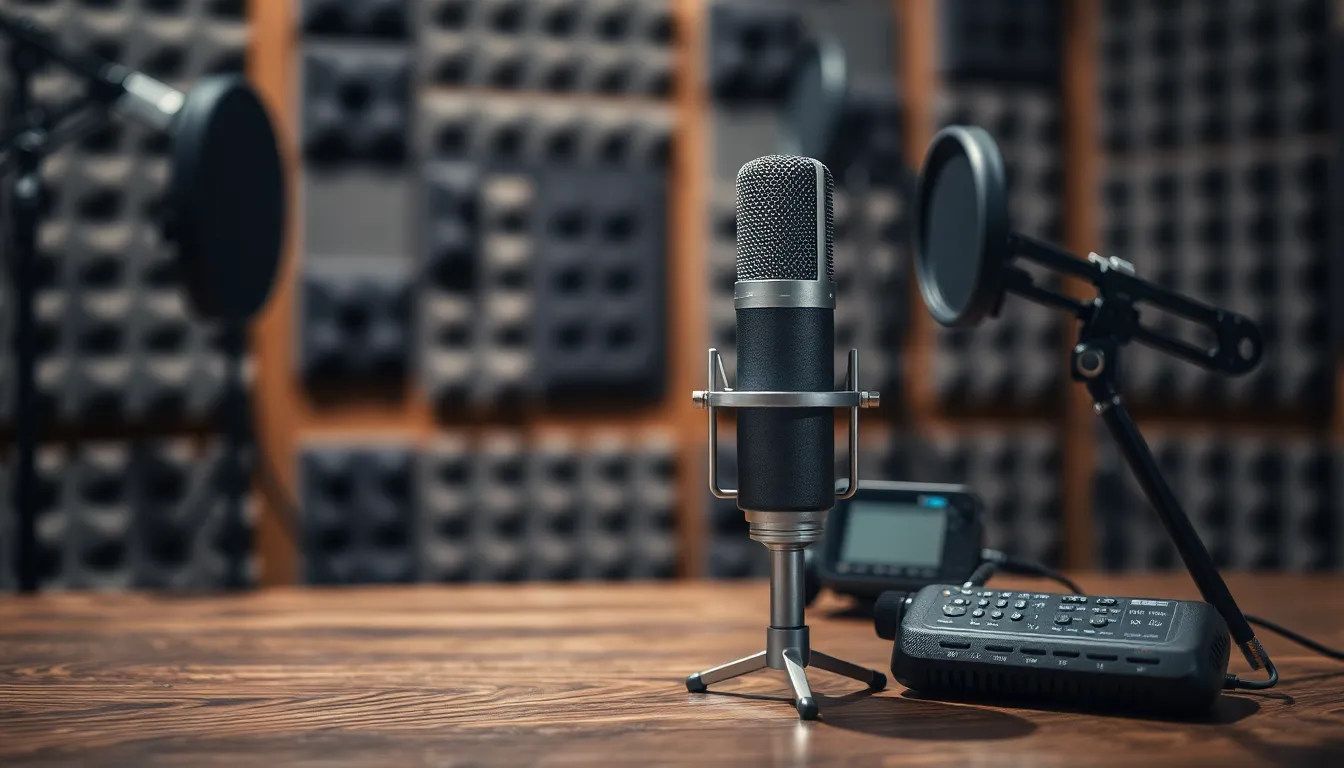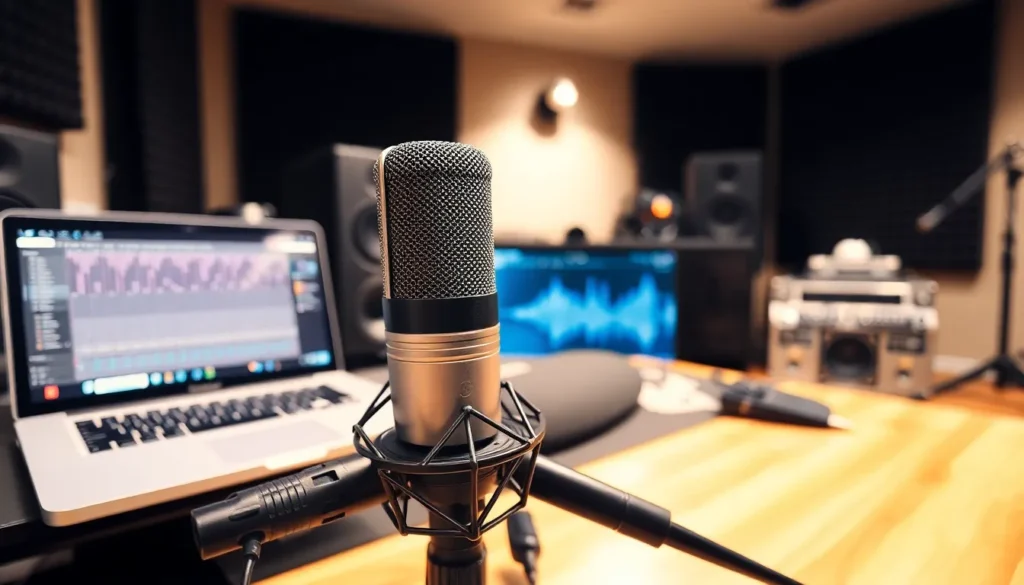In a world where every sound matters, audio capture technology is the unsung hero of communication. Whether it’s capturing the sweet serenade of a bird or the riveting speech of a CEO, this tech turns fleeting moments into lasting memories. Imagine recording that perfect melody or the laughter of friends at a party. With the right tools, every sound can be a story waiting to be told.
Table of Contents
ToggleOverview of Audio Capture Technology
Audio capture technology plays a vital role in various domains, including music production, broadcasting, and communication. It enables users to record sounds, creating a rich repository of audio experiences. Devices such as microphones and audio interfaces facilitate this process, allowing for high-quality sound recording.
Microphones convert sound waves into electrical signals, capturing everything from subtle whispers to powerful concerts. Popular types include dynamic microphones, known for their durability, and condenser microphones, favored for their sensitivity and clarity. Audio interfaces connect microphones to computers, enhancing sound fidelity and providing essential controls.
Recent advancements in software technology have further improved audio capture quality. Digital audio workstations (DAWs) offer tools for editing and mixing audio tracks, allowing users to enhance recorded sounds. Plug-ins within DAWs can also apply effects, giving recorded audio unique characteristics.
Smartphone applications have democratized access to audio capture technology. Users can effortlessly record high-quality audio on-the-go. Applications like Voice Memos and specialized recording apps facilitate quick captures of lectures, interviews, and spontaneous inspirations.
Additionally, advancements in wireless technology have enabled mobile audio capture. Portable recorders with Bluetooth capabilities allow for wireless operation, granting flexibility during recordings. Such innovations empower users to record in diverse environments, from busy streets to serene forests.
Audio capture technology continues to evolve, driving innovation in various fields. The integration of artificial intelligence into audio processing enhances the accuracy and efficiency of recordings. Users increasingly benefit from features like noise reduction and automatic leveling.
Types of Audio Capture Technologies

Audio capture technology includes various devices tailored to specific recording needs. This section covers key types, focusing on microphones and digital recorders.
Microphones
Microphones serve as essential tools in audio capture. They convert sound waves into electrical signals, capturing vocals and instruments with precision. Condenser microphones excel in studio environments, offering sensitive pickups for nuanced sound. Dynamic microphones work well in live settings, providing durability and handling high sound pressure levels. Ribbon microphones deliver a warm tone, making them ideal for certain musical applications. Lavalier microphones provide discreet audio capture for interviews and presentations. Each type caters to distinct recording contexts, enhancing overall sound quality and clarity.
Digital Recorders
Digital recorders represent another fundamental component of audio capture technology. These portable devices convert audio signals into digital formats, simplifying the recording process. Some models offer built-in microphones, while others connect externally for improved flexibility. Popular features include multiple track options, which allow for layered recordings, and various audio file formats for compatibility. Many digital recorders include onboard editing capabilities for quick adjustments. These tools suit musicians, podcasters, and content creators seeking high-quality audio on the go.
Applications of Audio Capture Technology
Audio capture technology finds its application in numerous fields, showcasing its versatility and importance.
Music Production
Music production heavily relies on audio capture technology for creating high-quality recordings. Musicians utilize various microphones to capture vocals and instruments with precision. Condenser microphones often serve in studios for their sensitivity, while dynamic microphones work well for live performances. Digital audio workstations play a critical role in this process, providing platforms for mixing and editing tracks. Producers leverage these tools to enhance sound quality, allowing artists to achieve their desired soundscapes and bring their visions to life.
Podcasting
Podcasting benefits significantly from advancements in audio capture technology. Podcasters use USB microphones for their convenience and quality, capturing clear audio for engaging episodes. Editing software enables them to refine recordings, eliminating background noise or adding music. This technology also allows remote interviews, making it easier for hosts to connect with guests from anywhere in the world. Furthermore, the portability of digital recorders means podcasters can capture content on the go, ensuring flexibility and spontaneity in their storytelling.
Field Recording
Field recording serves as another key application of audio capture technology, aimed at capturing sounds from various environments. Nature enthusiasts and sound artists often rely on high-quality portable recorders to document ambient sounds or wildlife. Directional microphones help isolate specific sounds, ensuring clarity despite potential background noise. These recordings enrich documentaries, video games, and sound libraries, offering authentic auditory experiences. Advances in technology even enable sound designers to implement innovative techniques, further enhancing the quality of field recordings.
Advantages and Disadvantages
Audio capture technology offers significant benefits and poses certain limitations that users should consider. Understanding these aspects helps users make informed decisions.
Benefits of Audio Capture Technology
Audio capture technology enhances communication, allowing users to preserve important sounds and experiences. It improves accessibility, giving individuals the tools to easily record, edit, and share high-quality audio using smartphones, microphones, and digital recorders. In creative fields, such as music production and podcasting, this technology enables artists to fine-tune their work, engaging audiences with polished content. Professionals in journalism and filmmaking benefit from high fidelity recordings that enrich storytelling. Furthermore, innovations like artificial intelligence optimize audio processing, increasing recording accuracy and reducing background noise.
Limitations and Challenges
Despite its advantages, audio capture technology faces several challenges. Quality can fluctuate significantly based on factors like microphone selection and recording environment, impacting final output. Users may encounter technical difficulties, particularly with more advanced devices, which require additional skill and knowledge. Battery life of portable recorders can limit long sessions, leading to missed opportunities. Additionally, privacy concerns arise around recording conversations without consent, raising ethical considerations. Lastly, reliance on technology can create barriers for those unfamiliar with the tools, hindering effective use.
Future Trends in Audio Capture Technology
Emerging trends in audio capture technology reflect advancements that enhance both user experience and recording quality. Integration of artificial intelligence plays a significant role, automating tasks such as noise reduction and sound enhancement. These capabilities allow users to focus on creativity rather than technical complexities.
Developments in wireless audio capture devices enable greater mobility and flexibility. Professionals can move freely while recording, which expands opportunities for capturing spontaneous moments. Additionally, miniaturization of equipment designs leads to smaller, more portable devices, ensuring high-quality audio remains accessible in various environments.
Collaborative software tools are gaining traction, enabling real-time editing and audio mixing among teams worldwide. Cloud-based platforms streamline workflows, allowing users to share recordings instantly and collaborate on projects from different locations. This trend nurtures a global ecosystem of creators exchanging ideas and improving audio quality.
Emerging technologies like spatial audio and ambisonics offer new ways to capture immersive sound experiences. These advancements elevate audio recordings by simulating three-dimensional soundscapes, enriching media content for entertainment and educational purposes. Creators are drawn to these technologies as they allow for more engaging experiences.
Environmental sustainability is becoming a priority in audio equipment development. Manufacturers are focusing on eco-friendly materials and energy-efficient designs to reduce environmental impact. This initiative aligns with growing demand for sustainable practices, appealing to conscious consumers.
Moving forward, user-centric designs will shape the future of audio capture technology. As user needs evolve, manufacturers will prioritize ease of use and enhanced functionality, ensuring audio capture remains intuitive. Ongoing advancements guarantee the technology will continue evolving, providing better solutions for various applications.
Audio capture technology continues to shape how individuals and professionals document and share their experiences. Its impact spans various fields from music production to journalism enhancing the quality and accessibility of sound recording. As innovations unfold users can expect even greater efficiency and creativity in their audio projects.
The integration of artificial intelligence and advancements in wireless technology promise a future where high-quality audio capture is more intuitive and user-friendly. With a focus on sustainability and portability the landscape of audio tools is set to evolve further. Embracing these technologies allows users to transform fleeting moments into lasting memories enriching communication and creative expression.





